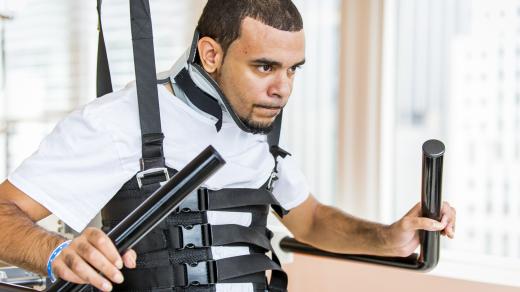Body
Her first clue was when her fingers turned numb.
When Dr. Lynn Rogers set out on an early-morning run in late July 2017, a week before departing for Canada to attempt her second Ironman triathlon, the then-40-year-old noticed that she couldn't feel her fingertips.
The following day, the tingling returned --but in her feet. Her tongue was next. Rogers went to the emergency room, where doctors performed a battery of tests but couldn't find anything wrong.
Rogers had been a fit, healthy, endurance athlete for over a decade. As director of the Neuralplasticity Lab at the Shirley Ryan AbilityLab (formerly the Rehabilitation Institute of Chicago), Rogers studied the brain and how it controlled movement. She was also a faculty member at Northwestern's medical school, balancing her love of scientific research with her passion for running and biking, waking up at 5 a.m. four to six days a week for training runs or rides. She loved jogging alongside her fellow triathletes and marathoners, a run club that had become a close-knit community that often traveled the country to race together.
Body
These new symptoms, however, were a mystery. At work the next day, Rogers' coworkers at the rehabilitation clinic ran her through several assessments. Rogers, fully sober, couldn't pass a basic sobriety test. She headed back to the ER and endured another series of tests, including a spinal tap. Still, doctors could find nothing wrong. Six days out from the Ironman, Rogers boarded a plane for Whistler, British Columbia, determined to compete. She'd spent the past nine months training, and she had numerous friends and family members flying to Canada to cheer her on.
But as soon as she deplaned, Rogers could barely walk. She reluctantly realized she couldn't race; instead, she cheered her friends from the sideline. By the end of the race, she couldn't stand without support. She went to bed that night and found herself unable to sleep. Horrific back pain felt like a metal band had wrapped around her chest, squeezing her like a constrictor. The tingling she'd experienced off and on had taken over her hands, arms, legs and feet. She began to comprehend the magnitude of what might be happening. And she was afraid.
Mentioned Page
Request an Appointment
Complete this short form and a representative will contact youBody
Aided by friends, Rogers made her way to the ER in Whistler, where doctors coordinated with physicians in Vancouver and Chicago. "They determined that if I could still breathe, I needed to get on a plane immediately," Rogers said. "That was the craziness we were in -- wondering if I would keep breathing long enough to get home." Rogers made it through the flight, and upon landing, she and her boyfriend, Tony, took a cab straight to Northwestern Memorial Hospital. Only this time, she wouldn't leave so quickly.
She continues to amaze us. It's quite striking how much she's doing and keeping physically active. Her workouts and her activity level are much more than I expected.
Dr Elliot Roth, Co-Medical Director, Brain Innovation Center
Body
After three weeks in the acute ward, Rogers was moved to the Shirley Ryan AbilityLab rehabilitation clinic -- the same place where she worked as a research scientist. But two weeks into physical therapy, Rogers wasn't improving.
In fact, her condition had worsened, so she was transferred back to Memorial. There, doctors tried a different treatment called a plasma exchange, in which Rogers' plasma is taken from her body via a catheter, run through a machine where her blood cells are matched with donor plasma and then reinserted into her body. She received seven treatments over 14 days and slowly regained mobility. Still, even tiny movements caused extreme pain. Rogers could barely move her ankles -- simply bending and straightening was excruciating. When she tried to sit up, it felt like her hamstrings would rip in half.
Body
In November, Rogers was admitted as an in-patient at the AbilityLab, requesting that she stay on the 23rd floor, the same floor as her own research lab. She had physical therapy several feet away from her desk and the research team of scientists she supervised in studying patients like herself.
Rogers was also determined to run again. She had lost 25 pounds of muscle, and she relied on ankle braces, crutches or a wheelchair for mobility. But in November, she stepped onto an anti-gravity treadmill, wearing a harness to support half of her body weight. "It felt like an elephant running, because I was just smashing down on myself," Rogers says. Each day, she assumed a little more of her weight while trying to run on the treadmill.


